Bordered dracaena ( Dracaena marginata) , another name – dracaena marginata – a variety of bent dracaena (D. reflexa) from the dracaena family, one of the most unpretentious species used for indoor breeding.
Description of the marginata plant
Dracaena bordered or marginata is a slender evergreen tree that grows naturally on the islands of Madagascar and Reunion, where it reaches a height of 3-5 m. The trunk of the plant is little branching, over time it becomes very bare, trapezoidal scars form in place of fallen leaves. Sessile leaves collected in bunches are hard, long, narrow-linear with a pointed end, their width is 1-2 cm, length – up to 50-70 cm. to the sides and down.
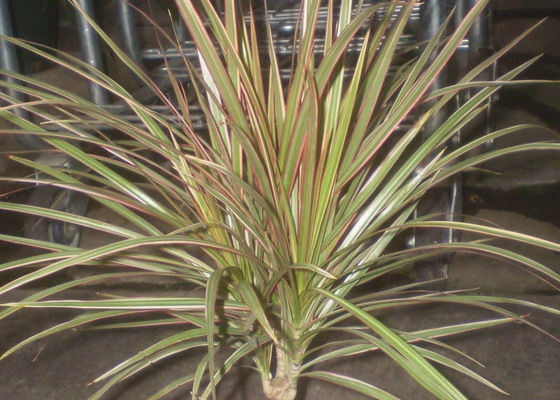
Dracaena marginata in the photo
The plant is also known under the names, “Madagascar dragon tree”, “red-bordered dracaena”. A characteristic feature of the culture, reflected in the name, is its coloring.
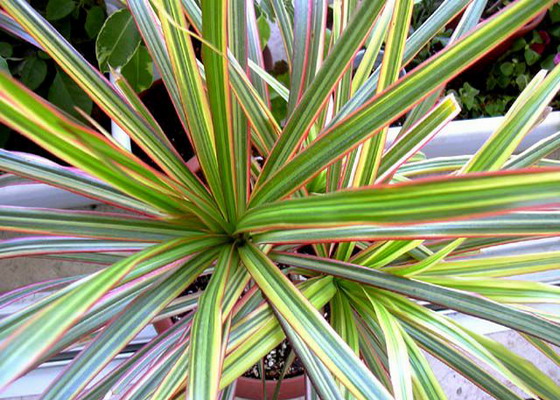
Dracaena leaves bordered in the photo
As you can see in the photo, bordered dracaena has green leaves with a reddish-purple border around the edge. Currently, several varieties have been bred that have an even more original color.

Dracaena Tricolor pictured
So, in the Tricolor variety, the green and red stripes are separated by yellow, and in general the leaf looks golden green.
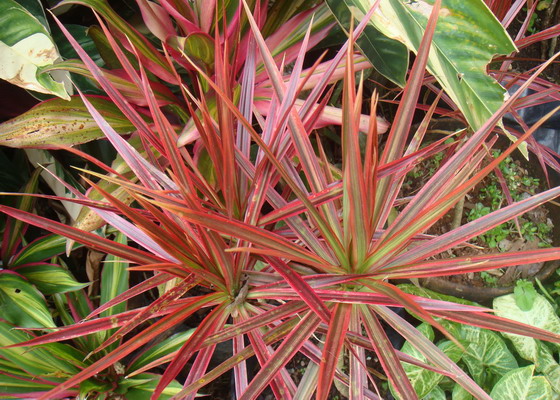
Dracaena Colorama in the photo
The Colorama cultivar has wide red stripes that give the entire leaf a red color.
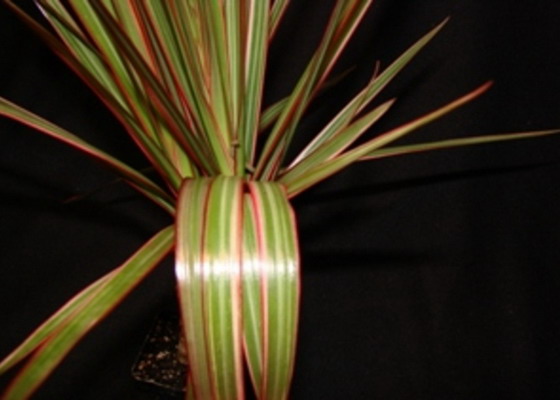
Dracaena Bicolor pictured
In the Bicolor variety, longitudinal pink stripes are placed on narrow leaves.
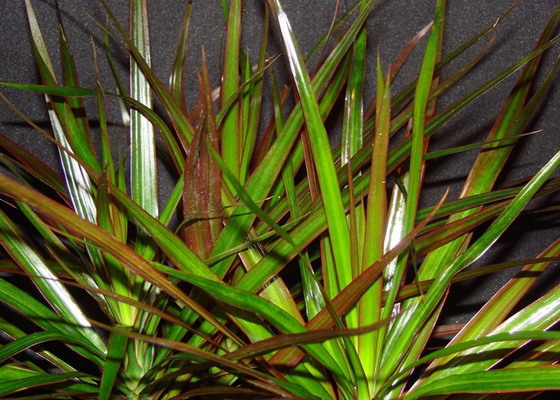
Dracaena Magenda in the photo
There is a Magenda variety, which has long narrow green leaves edged with a thin red or crimson border. Above are photos of the dracaena marginata of some of the listed varieties.
Due to its unpretentiousness, spectacular appearance and simple care, bordered dracaena has long been grown in room culture. During the Victorian era, it was one of the most popular houseplants, and in modern times it is increasingly used in interiors of both offices and apartments. Indoors, individual specimens can grow up to 3 m, over time they become similar to a palm tree: the trunk becomes bare and stiff, and the leaves collected in a bundle at the point of growth remain only in the upper part of the trunk, sometimes twice or thrice branched. An additional advantage of the flower is its ability to purify the air by absorbing the vapors of formaldehyde, trichlorethylene and xylene contained in the air of modern apartments. In room conditions, the plant practically does not bloom.
Features of caring for dracaena bordered or marginated
Since marginata dracaena is easier to care for than most other indoor crops, this species is very widely grown in different countries as a single, especially tub plant. It requires minimal attention to itself, develops well at room temperature both in summer and in winter, tolerates dry soil and irregular watering more easily than other flowers. High temperature and illumination, including artificial light, characteristic of office premises, corresponds to the growth conditions of this species, which explains its widespread use for decorating offices and industrial premises.
Despite the unpretentiousness of the dracaena marginata, caring for it has a number of features. The plant does not tolerate any, even the most insignificant damage to the leaf plates, which immediately affects its growth mode. In case of any damage or the appearance of deformed leaves, it is better to remove them immediately. A place for a container with dracaena must be chosen carefully so as not to rearrange it later; for a thin unstable trunk, it is mandatory to use a support.
The culture, especially its green varieties, tolerates penumbra well, but it must be remembered that spectacular variegated forms with a lack of light can become monochromatic green, it is better for them to choose well-lit places protected from direct sunlight. The plant grows well near east and west windows.
For dracaena marginata, watering should be moderate, since its roots are very sensitive to waterlogging. In summer, the plant is watered abundantly, but only after the top layer of soil in the pot dries out by 2-3 cm. In winter, watering is limited, preventing the earthen clod from completely drying out. At high room temperatures, the frequency of watering should be increased. To aerate the soil, which provides air access to the roots, it is recommended to loosen the top layer of soil in the flowerpot at least once a month.
They are fed with a special fertilizer for dracaena and palm trees, or complex flower, in the summer time every 2 weeks, in the winter once a month, using a half dose.
The flower can grow in the dry air of rooms with central heating, but to prevent drying of the tips of the leaves, it is recommended to spray it or wipe it with a damp sponge 1-2 times a day. To improve the decorative effect, you can trim the dry ends of the leaves, but it is unacceptable to cut them to a living tissue, this can provoke further drying out. A warm shower has a beneficial effect on the plant, cleansing the leaves from the dust settling on them.
To limit growth, the top is cut off, leaving a certain number, usually 4-5, of leaves on the trunk. The cut point must be treated with garden pitch or filled with paraffin. After pruning, new growth points often form (leaf tufts when pruned in the leaf area, new stem growth buds when pruned on a bare area of the trunk). To stimulate this process, you can put a plastic bag on the cut site. The cut off top is easily rooted, if after that it is planted in the same pot, an interesting composition of several tiers of the plant will be obtained.
For young dracaena marginata, transplantation is recommended every 2-3 years, trying not to damage the earthen clod. In adult specimens growing in tubs, replace about 5 cm of the top layer. Use ready-made soil for palm trees and dracaena, to which coarse-grained sand, pieces of charcoal or brick chips can be added.
Plants are practically not subject to pests and diseases . Marginate dracaena are occasionally affected by scale insects, spider mites, and mealybugs. To get rid of them, spraying with insecticides is used. Of the diseases of the bordered dracaena, leaf spots caused by fungi are found. Treatments are carried out with fungicides and copper-containing preparations.
Reproduction of dracaena bordered (marginata)
Reproduction of bordered dracaena is best done during the period of active growth, that is, early spring. Only vegetative methods are used: apical cuttings, segments of stems, air layering.
When using apical cuttings, after processing the cut with a root root, they are rooted in moist soil, covering the cutting with polyethylene to create high humidity. The cuttings root easily in water, and it is necessary to ensure that the leaves do not come into contact with it. Activated charcoal can be added to water for disinfection. In this case, the roots appear after a couple of weeks, after 30 days they can be planted in a pot.
When propagated by segments of the stem, they are cut into pieces 5-7 cm in size, the upper cut is treated with garden pitch or paraffin, the lower one with root, after which they are planted in a container with a layer of nutrient soil of 5-7 cm and on top of the same thickness layer of sand. Pieces of the stem are deepened into the sand by 2 cm, the emerging roots subsequently penetrate into the substrate layer. A rooted cutting can be left to grow in the same container without replanting or injuring the root system. Stem cuttings can also be rooted in water, although the percentage of survival is lower than for apical cuttings.
If the above propagation methods fail for some reason, you can propagate the dracaena in a more complicated way, by air layering, without separating the cutting from the mother plant until the roots form.







